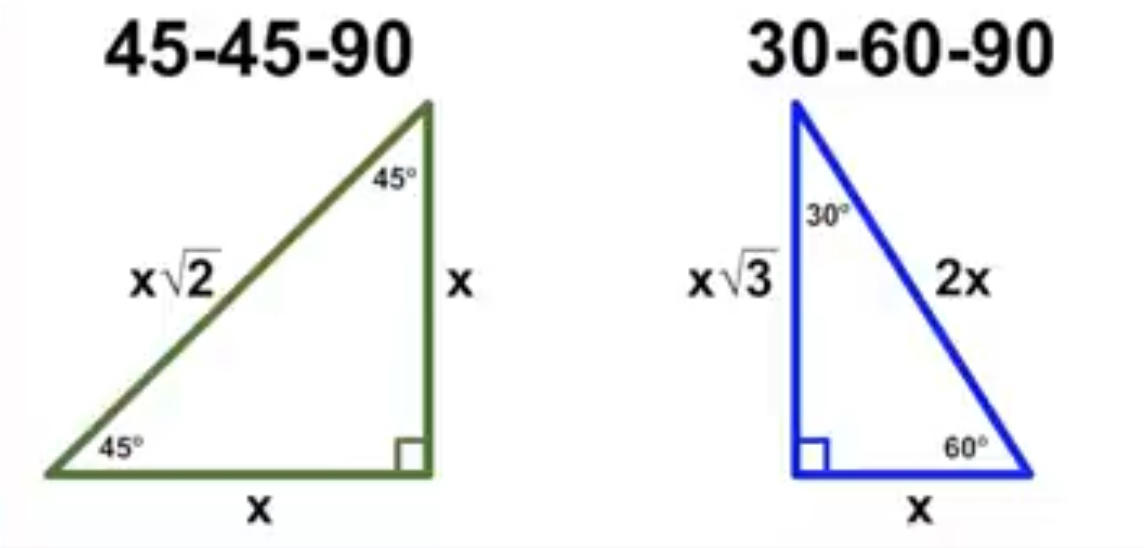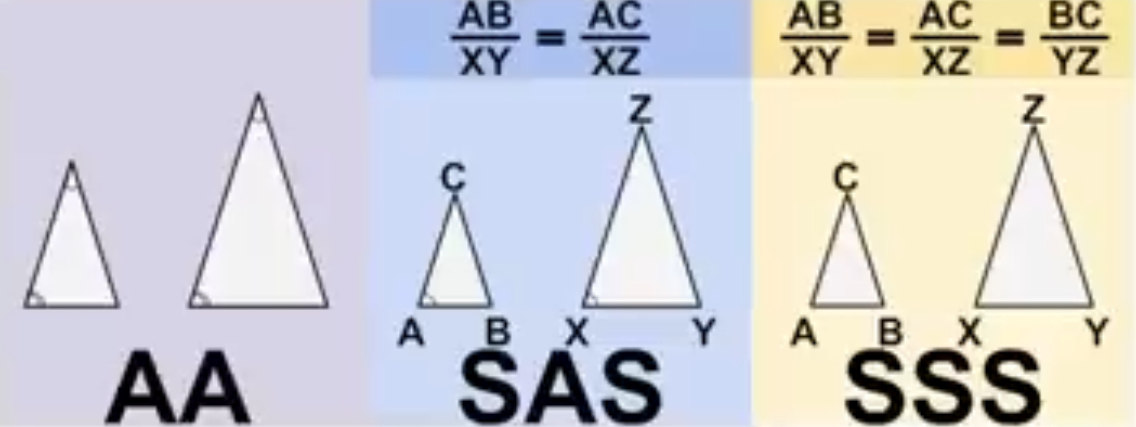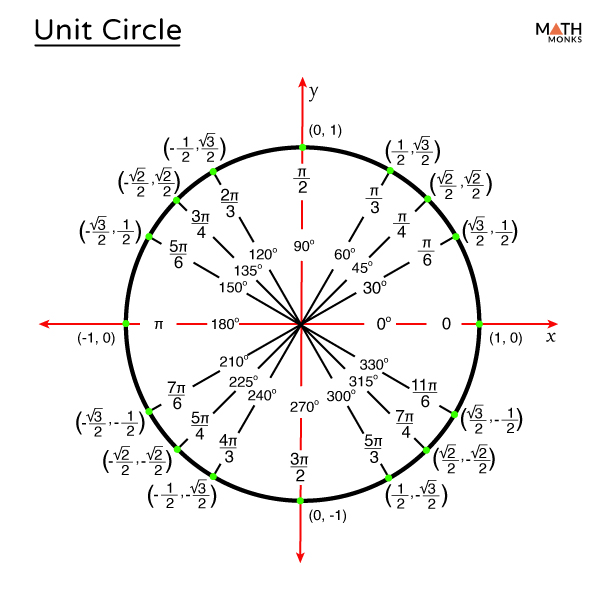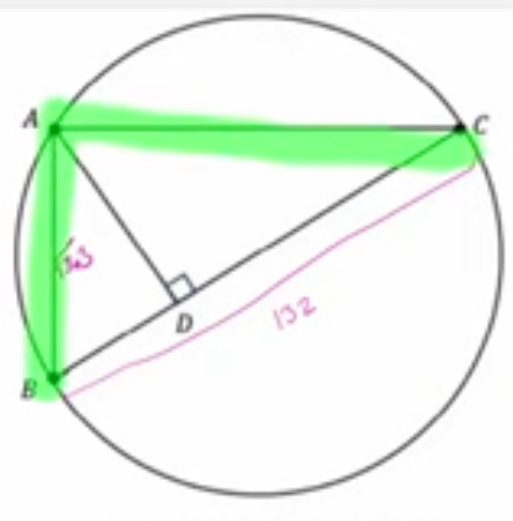(digital) math sat practice
1/75
Earn XP
Description and Tags
formula/content *must know* for the math portion of the dsat; content sourced from: Scalar Learning (YT), Epic Prep (YT), LearnSATMath (YT), Google, The College Panda (textbook), ChatGPT, & Lance Sakarda (YT).
Name | Mastery | Learn | Test | Matching | Spaced |
|---|
No study sessions yet.
76 Terms
point-slope form
y - y1 = m(x - x1)
*use when you have the slope and a coordinate
same slope, different y’s
parallel lines
circle formula
(x - h)2 + (y - k)2 = r2
(h, k) = center of the circle
r = radius
slope of a line when given coordinates
m = y2 - y1 / x2 - x1
slope intercept form
y = mx + b
m = slope → rise/run
b = y-intercept
midpoint formula
(x1 + x2 / 2 , y1 + y2 / 2)
*midpoint = average of two points
distance formula purpose
to find radius of circle, given center point/one exterior; to find hypotenuse w/o pythagorean theorem
distance formula
d = √(x2 - x1)2 + (y2 - y1)2
length of an arc formula
L = (n/360)2πr
n = angle made by r; L = arc length (ex: crust of the pizza slice)
area of a sector
A = (n/360)πr2
A = area of the slice of pizza
n = angle given of sector
find values of x from quadratic equation
factor
ax² + abx + ab = 0
(ax + b)(x + a)
ax + b = 0; x + a = 0
(the last ab value = c for this example)
quadratic
1/2(a) (-b ± √b2-4(a)(c))
when quadratic equation = 0, x values are the solution
(you don’t need to multiply by 1/2a as long as you divide everything by 2a—it’s the same thing, written this way to accommodate formatting limitations)
quadratic standard form
y = ax2 + bx + c
when quadratic equation = 0, x values are the solution
soh cah toa
sine = opposite/hypotenuse
cosecant = hypotenuse/opposite
cosine = adjacent/hypotenuse
secant = hypotenuse/adjacent
tangent = opposite/adjacent
cotangent = adjacent / opposite
similar triangles (same angles + proportionate side lengths)
sine of corresponding angles are equal
probability
number of favorable outcomes / total number of outcomes
exponential growth
y = a(1 + r)t
a = initial value; r = growth rate; t = time
exponential decay
y = a(1 - r)t
a = initial value; r = decay rate; t = time
vertex of a parabola formula when in quadratic standard form
(x, y)
x = -b/2a
y = x plugged back into the original equation (that you got the b and a values from)
vertex form
y = a(x - h)² + k
vertex: (h, k)
pythagorean theorem
a2 + b2 = c2
a & b = legs
c = hypotenuse
special right triangles
45º-45º-90º → leg 1: x, leg 2: x, hypotenuse: x√2
hypotenuse ÷ √2 = leg
30º-60º-90º → small leg: x, big leg: x√3, hypotenuse: 2x
small leg x √3 = big leg
big leg ÷ √3 = small leg
small leg x 2 = hypotenuse

distance formula (rate)
d = rt
d = distance; r = rate (rate = speed); t = time
*units of rate must equal units of time
sine/cosine relationship
*sin(x) = cos(90 - x)
x = angle
90 - x = complement of that angle
sin(10) = cos(80)
sin(20) = cos(70)
sin(30) = cos(60)
sin(40) = cos(50)
sin(50) = cos(40)
sin(60) = cos(30)
sin(70) = cos(20)
sin(80) = cos(10)
*equals 90º → definition of complementary angles: two angles that up to 90º
sum of solutions of quadratic
0 = ax2 + bx + c
sum of solutions = -b/a
product of solutions of quadratic
0 = ax2 + bx + c
product of solutions: c/a
discriminant (of quadratic)
0 = ax2 + bx + c
b2 - 4(a)(c)
discriminant = stuff under the radical in quadratic formula
find number of solutions (quadratic)
use discriminant to solve
x < 0 (negative; imaginary solutions) → no real solution
x = 0 → one real solution
x > 0 (positive) → two real solutions
area of equilateral triangle
∆ → all sides equal s
area of equilateral triangle = s2√3/4
pythagorean triples
3-4-5
6, 8, 10 (× 2)
9, 12, 15 (× 3)
12, 16, 20 (× 4)
15, 20, 25 (× 5)
5-12-13
10, 24, 26 (× 2)
15, 36, 39 (× 3)
20, 48, 52 (× 4)
25, 60, 65 (× 5)
7-24-25
14, 48, 50 (× 2)
21, 72, 75 (× 3)
28, 96, 100 (× 4)
35, 120, 125 (× 5)
8-15-17
16, 30, 34 (× 2)
24, 45, 51 (× 3)
32, 60, 68 (× 4)
40, 75, 85 (× 5)
*multiply all sides by a value to find the sides when you know its a pythagorean triple
perpendicular slope
slope → m = a/b
perpendicular slope (opposite reciprocal of slope) → m = -b/a
slope of parallel lines
slope → m = a/b
parallel slope → m = a/b
*slopes are the same
sum of angles formula (for any polygon)
sum = (n - 2)180º
n = number of sides
rational functions
x-intercept
equation: set numerator equal to zero
graph: where the line touches the x-axis (same as the zeroes)
y-intercept
equation: plug in 0 for x in the equation
graph: where the line touches the y-axis
vertical asymptote
equation: set denominator equal to zero
graph: find the line the function is approaching but never meeting
horizontal asymptote
equation: f the degree of the numerator is less than the degree of the denominator, it’s y = 0; if the degree of the numerator is equal to the degree of the denominator, y = leading coefficient/leading coefficient; if the degree of the numerator is greater than the degree of the denominator, there is no horizontal asymptote)
graph: find the line the function is approaching but never meeting

triangle congruence theorems
SSS - side-side-side
SAS - side-angle-side
ASA - angle-side-angle
AAS - angle-angle-side
HL - hypotenuse-leg
*the letters of these theorems must be in this exact order
triangle similarity theorems
SSS - side-side-side
SAS - side-angle-side (congruent angles, proportionate sides)
AA - angle-angle
*sides proportionate and not congruent; angles are always congruent

unit circle

sin(Θ) = y-value (y / r)
cos(Θ) = x-value (x / r)
tan(Θ) = y / x
exponent rules (7)
xa • xb → xa+b
(xa)b → xa•b
xa / xb → xa-b
x-a → 1 / xa
x0 → 1
x1 → x
xa/b → b√xa
absolute value
|ax - b| = c
two equations:
ax - b = c
ax - b = -c
solve for x → two solutions
inequalities
-ax - b < c
*-ax < b+c
*when dividing (or multiplying) -a on both sides, you have to switch the sign
*answer: x > b+c/a
solutions in systems of equations
no solution = parallel lines (same slope)
infinite solutions = same line (same slope, same y-intercept)
one solution = lines intersect at a single point (different slopes)
inscribed angle theorem
any inscribed angle that extends from the same arc as the center angle will always be ½ of the center angle
inscribed angle theorem of the diameter
if a point lies on the circumference and is connected to the endpoints of the diameter, it forms a right angle with the diameter

simple interest formula
A = p (1 ± r)t
A = amount; p = principal amount; r = rate; t = time
compound interest formula
A = p (1 ± r/n)nt
A = total amount; p = principal amount; r = rate; n = number of times interest is applied per time period; t = time
integer vs. non-integer
integer: positive/negative whole number (including zero)
non-integer: not a whole number/zero; decimal or fraction
use vertex form for quadratic (minimum or maximum)
y = a(x - h)² + k
positive a: parabola opens upwards and k represents the minimum value
negative a: parabola opens downwards and k represents the maximum value.
when there’s one solution between a quadratic and horizontal line
the solution is at the vertex (its x-value, unless the y-value is asked for)
when to use desmos for no solution problems
quadratic = YES
systems of equations (linear) = NO (just make the slopes equal)
percent change formula
percent change = 100% (new value - original value / original value)
*if the problem is worded as “percent greater/less than,” the quantity that comes after “than” should be taken as the original value
p% of x
p/100 × x
p% greater than x
(1 + p/100)x
p% less than x
(1 - p/100)x
square inscribed in a circle
the diagonal of a square is equal to the diameter of the circle it is incribed in
square relationship between its diagonal and side lengths (formula)
d = s√2
d = diagonal / diameter; s = side length
when to use desmos
finding the vertex (graph)
x/y-intercepts (graph)
quadratics that intersect at 1/0 points (graph)
finding (basic) mean/median (built in feature, check “functions”)
finding points on a circle (graph)
systems of equations/inequalities (graph)
don’t use when there are more than two variables unless you are extremely well-versed in demsos and know how
number of solutions (graph)
(note: there’s probably more ways to use desmos, but to keep it short: use it for most function problems, to check your work, and whenever YOU think you can fit it into some random problem to solve—that said, a normal calculator is quicker to operate for basic math like +/-/÷/× and desmos DOES NOT work for every problem type—look into YT videos for specifics on this—and DO NOT waste your time if you’re confused when to use it, but you had better know how)
180º
equals π radians
degrees/radians conversion
degree = radian × 180/π
radian = degree × π/180
standard deviation
the spread of data from the mean
standard form of a linear equation in one variable
ax + by = c
a = coefficient of x (cannot be 0)
x = -b/a
b = constant term
y = when x = 0
c = constant
average rate of change formula
rate of change = change in y / change in x
zero of a linear function
*when y equals 0
0 = mx + b → x = -b/m
systems of equations
USE DESMOS FIRST—IT WILL ALMOST ALWAYS SAVE YOU TIME FOR THESE PROBLEMS; to do so, just plug in both equations in, separately, and find the value you need/solve accordingly (see where the lines intersect one another or the x/y-intercepts)
that said, use the traditional methods, below, if you can’t use desmos to solve it for whatever reason
substitution method: solve for x or y for one equation → plug whatever x or y equals in the other equation’s x or y to find the variable you don’t have → find the initial variable you solved for by plugging in the variable you just found (so you get an actual number)
elimination method: multiply both equations by a value that makes either the x’s or y’s the same number but with opposite signs (ex: multiplying the top equation by 3 to get 6x and the bottom equation by -6 to get -6x so they cancel out and you solve for y)—all of the numbers/variables are multiplied by the relevant number of your choosing → plug this equation into the smaller/easier equation to get one variable → plug in this value into one of the equations to find the other variable
linear standard form
Ax + By = C
linear standard form to slope-intercept form
Ax + By = C → y = -A/Bx + C/B
slope-intercept form to linear standard form
y = mx + b → mx - y = -b
y = 0/singular number
straight horizontal line; line goes infinitely only carrying its y-value
x = 0/singular number
straight vertical line; line infinitely long only carrying its x-value
slope in standard linear equations
m = -a/b
m = slope; -a = negative a value; b = b value
(in this equation: ax + by = c)
mean
the average
find mean from a set of numbers
add all numbers together
divide by the amount of numbers there are
**do this by hand or by using Desmos
median
the middle number in a list of numbers
find median in the set of numbers
find the number in the very middle in numerical order from least to greatest
if there are two numbers in the middle, find the average of them (meaning, add them together and then divide by two)
mode
the number that appears most frequently in a set of numbers
range
biggest number - smallest number = range, in a set of numbers
when to complete the square
when you can’t factor
to convert quadratic form to vertex form (find vertex — min/max)
complete the square